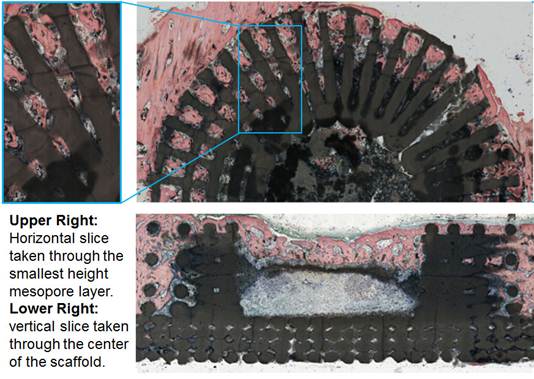Objective: 3D-printed, Direct Write (DW), scaffolds composed of tricalcium phosphate with temporary calcium sulfate filler can be custom-fabricated to repair complex bone defects. Current literature debates mesopore sizes for bone repair. The objective is to examine the relationship between scaffold pore size and bone density, ingrowth, and remodeling. This will allow us to design scaffolds that regenerate cortical-like or trabecular bone.
Methods: Mesopores (spaces defined by struts) varied in all dimensions. 11mm diameter disk scaffold designs with layers of nested concentric circles, alternating with radial struts stacked in z height, were DW printed of 15:85 HAP/β-TCP ink and filled with temporary calcium sulfate cement. This design results in a series of wedge-shaped mesopores, where size decreases in a controlled linear series from 940µm (outer edge) to 100µm at center. Scaffolds (N=7) for two designs were placed in rabbit bilateral trephine defects. After 8 weeks, bone ingrowth and remodeling were quantified by microCT and hard tissue histology.
Results: Calcium-sulfate dissolved ahead of the bone ingrowth front. Larger pore sizes allowed more bone ingrowth and scaffold remodeling was related to amounts of bone present. As mesopore size decreased, bone volume decreased from 40% to 9% of total volume and scaffold remodeling decreased from 13% to 5%. Significant bone ingrowth occurred in mesopores ranging from 100µm to 940µm, contrary to previous literature findings. The smaller mesopores resulted in cortical-like bone and the larger mesopores resulted in trabecular-like bone.
Conclusions: Bone density was higher in the more open, less scaffold-strut dense areas. Bone grew into all varied mesopore dimensions. This study demonstrates the properties of unique variable porosity bone repair scaffolds with varying densities that result in bone type ranging from cortical-like to trabecular. This information can be used to custom-design scaffolds for a wide range of complex bone defects.
Keywords: Biomaterials, Bone repair, Oral surgery, Osteoblasts/osteoclasts and Remodeling
![[ Visit AADR's Website ]](images/banner.jpg)
